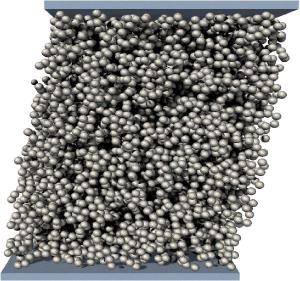Blog
Sticky Sticky Bubble Gum
20 November 2013
One of the challenges of understanding the formation of planetary systems is just how small clumps of matter become bigger clumps of matter. On scales large enough for gravity to play a significant role, we can model meteoroids and planetoids as as clumping due to their gravitational weight, but for small dust particles and clumps of molecules, gravity plays almost no role in clumping. Instead it is driven by things like surface adhesion, and this is very difficult (or nearly impossible) to study experimentally in the lab. So another approach is to study this behavior using computer simulations.
A recent paper in Astronomy and Astrophysics presents the results of just such a simulation.1 In this particular work the team looked at the interactions of dust particles on the millimeter scale. Understanding such interactions is crucial to understanding clumping on the scale of millimeters to kilometers. The team then simulated the interactions of porous, spherical dust grains, and determined the shear strength and tensile strength.
 Seizinger, et al.
Seizinger, et al.Shear strength and tensile strength are important measures of a bulk material. Basically, shear strength is a measure of how a material stands up to a sliding of upper and lower regions trying to move in opposite directions. Imagine you had a deck of playing cards on a table, placed your hand on top of the deck, and slid your hand to the side. The stack would shift diagonally due to the shear between the table and your hand. A similar shift can be seen in the model, as seen in the image here.
Tensile strength is a measure of how a material stands up to being pulled at opposite ends. For example, if you held the ends of a string and pulled, the tensile strength of the string would determine how hard you could pull before it broke.
The tensile and shear strengths of dust clumps determines how well the clumps can stand up to being knocked about by other dust clumps, as well as how likely two clumps are to stick together. The team ran simulations of clumps under different conditions, and determined a description for the tensile and shear strengths.
But how do they know the simulations are correct? It turns out we do have some experimental data on tensile strength. When the authors compared their theoretical model to the experimental data, they found it agreed really well. With the shear strength, they could only compare their results to other theoretical results, and they found theirs differed significantly. This could mean their shear model is wrong, or it could mean they finally got it right.
But the team was also able to match their results to mathematical functions that depends on how porous the dust grains are. This is useful because future models can use the functions directly rather than re-simulating the dust grains. Specifically they can be used for what are known as continuum models, where the dust can be treated as a kind of continuous fluid (which makes larger simulations easier to do).
So a millimeter scale simulation has produced results that can be used in larger simulations. In the future we’ll have to see if those larger simulations agree with observation.
Seizinger, Alexander, Roland Speith, and Wilhelm Kley. “Tensile and shear strength of porous dust agglomerates.” Astronomy & Astrophysics 559 (2013): A19. ↩︎